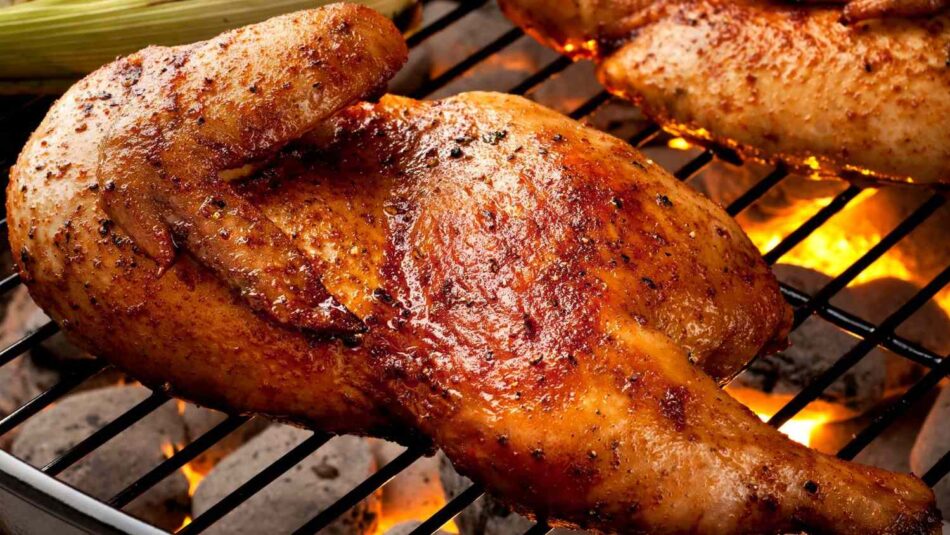Food science is an amazing thing. It’s always fun to remember that there are basic qualities to every food product that make it taste a certain way—when manipulated, blended, mixed, and cooked, just a few ingredients can make a simple dish taste out of this world. Barbecue chicken is my favorite example of how a humble ingredients—acid like vinegar and a little fat like oil—completely transform a cut of meat like chicken when combined at the right time and applied to the hot heat of a charcoal or wood-fired grill.
Cornell Chicken is the poster child for a perfect barbecue chicken recipe, and it makes sense that a food science professor developed it, because all of those elements are considered—and simplified—to form a straightforward yet innovative recipe. It’s just a few ingredients, but it smartly includes a raw egg which helps bind and emulsify the marinade to the chicken throughout the grilling process. It’s tangy and juicy, sealing in a tender, moist, and flavorful interior.
What is Cornell Chicken?
Cornell Chicken is a grilled barbecue chicken recipe developed by Dr. Robert C. Baker, a poultry and food science professor at Cornell University. The recipe, which was developed with the sole purpose of promoting and supporting the poultry industry in New York, uses an apple cider vinegar marinade.
Similar to North Carolina barbecues that incorporate a more vinegary sauce, Cornell Chicken is certainly apple cider vinegar-forward—a possible homage to the apples of upstate New York where Cornell is located. However, perhaps the most compelling thing about the recipe is not the use of cider vinegar in the marinade, but a raw egg. Blended together, with the oil and vinegar, the proteins in the egg help the vinegar and oil emulsify, which in turn helps a solid layer of tasty marinade adhere to the chicken even as it sits on the grates of the grill.
History of Cornell Chicken
Baker developed the recipe during his time working at Penn State University, but it only later gained popularity during the height of his career promoting the poultry industry at Cornell. From the time he joined the faculty to 1999, he set up shop at the New York State Fair selling Cornell Chicken to an adoring crowd that eventually included President Bill Clinton and his family. According to Cornell University, Baker’s daughter Reenie presented the President with apples to which he replied, “Those apple look good, but where’s the chicken?”
Even with its popularity throughout the region—and eventually beyond—the innovative technique of Cornell Chicken was just a drop in the bucket. Baker went on to found Cornell’s Institute of Food Science, and later developed food products that are key to our food system today: chicken nuggets. Baker is credited with figuring out a way to ensure the breading adheres to the chicken throughout the frying process on an industrial scale. Next time you pop a few frozen chicken nuggets in the oven or order a six-piece combo in the drive-thru, you have Baker to thank.
How to Make Cornell Chicken
Dotdash Meredith Food Studios
Cornell Chicken isn’t just any other barbecue chicken recipe. It has a few unique quirks that make it special. For instance, it calls for a relatively small chicken cut in half. (This is because Cornell Chicken was originally developed to support small-scale farms to help them sell smaller chickens.) The marinade famously also famously requires a single egg—an homage to the full cycle of the poultry industry, but also an integral element of the perfectly emulsified marinade. Here’s the basic step by step breakdown of the recipe as a whole:
- Cut a small (3 to 4 pound) chicken in half. This helps the marinade penetrate all the bits of the chicken—inside and out. If you’re nervous about cutting a chicken in half, ask the butcher to do it for you.
- Blend together the ingredients for the marinade. The marinade consists of two parts apple cider vinegar to one part vegetable oil. To this combination, you’ll also add sat, poultry seasoning, ground black pepper, and exactly one large egg. (To get ahead of any food safety concerns, use a pasteurized egg.)
- Marinate for at least 4 hours. Place marinade and chicken halves in a large resealable plastic bag in the refrigerator for 4 hours and up to overnight.
- Grill. Lightly oil clean grill grates and remove the chicken from the marinade, reserving some of it for brushing and basting. Grill skin side down, turning, brushing, and basting until the temperature reaches 165 degrees.
- Let rest before slicing. It’s important to let the chicken rest before slicing and eating, as this helps the juices reintegrate and relax the fibers of the meat, for a super yummy result.
Get the recipe: Cornell Chicken






